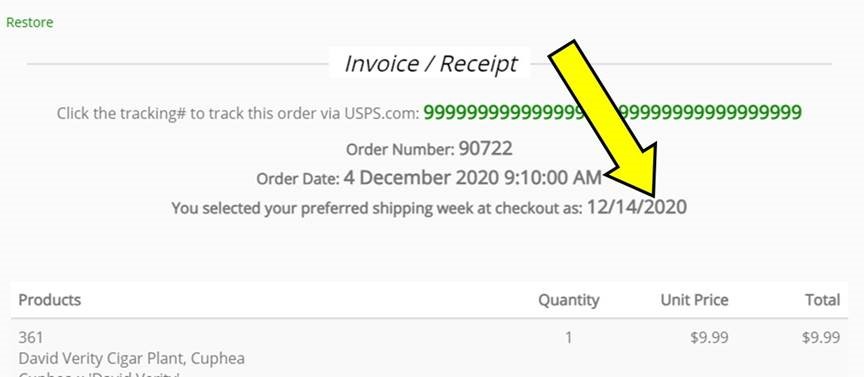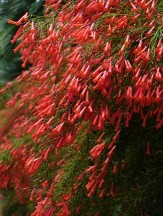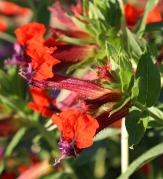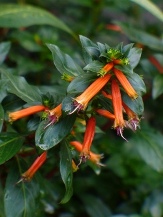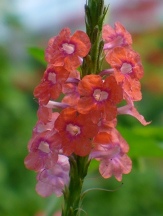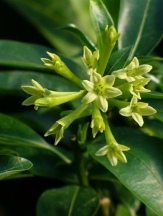Almost Eden's Frequently Asked Questions
Frequently Asked Questions
If there is a question that you have that you feel is not fully answered below or on our Growing Guides pages, please feel free to contact us via our "Contact Us" page, via email at john@almostedenplants.com, or via telephone at (337) 375-2114. We are more than happy to work with you and assist you in anyway that we can.
Click the question to see answer below it
Click here to see a simplified list of our detailed planting, growing, watering, or other plant care information guides below or visit our Growing Guides webpage:
- Angel's Trumpets
- Azaleas
- Cactus & Succulents
- Camellias & Sasanquas
- Container Plants
- Coral Honeysuckle
- Gardenias
- Growing Tropicals on the Edge of Hardiness Zones
- Hardy or Perennial Hibiscus - including Confederate Rosemallow
- Mulching Plants
- Night Blooming Cereus & Epiphyllums or Orchid Cactus
- Once-Mown Meadow Creation
- Planting a New Plant in the Garden or Landscape
- Plumerias
- Pride of Barbados
- Sambac Jasmine
How to set or reset your password for your Almost Eden account?
For added security we have changed our user log-in system to require a password. To set up your Almost Eden account to use a password for login you will need to use the “Reset Password” link. From that page, using your last name and email address you can then send yourself an email link where you can set or reset your password. Please note that the email address and last name are case sensitive and it is always possible that the reset email could end up in your SPAM folder. If you are unable to get this reset link to work please feel free to contact us and we’ll be glad to assist you.
How can I get notified about out-of-stock products?
The plants that we have listed on our website are all plants that we are currently working to propagate and/or grow and intend to have again in the future, hopefully this growing season.
To receive an automatic one-time email notification for out of stock products when we add that product back into inventory, you can simply follow the steps below:
- Sign in to our website using your last name and email address or if you have not registered you will need to do so on our Customer Registration web page
- Go to the product that you are interested in being notified about
- Click on the green "Email Me When Ready" link below the "Temporarily Out of Stock" message
- The message will turn black and change to say "You are set to be notified when these are back in stock."
- As soon as we add that item back into the inventory you will receive a one time email notification stating that the plant is back in stock.
- Please be sure to add "@almostedenplants.com" to your email whitelist or safe senders list to be sure that our emails do not end up in your SPAM folder.
- Note: You may not be the only person waiting for this plant to come available again and it is always possible that we will sell out before you get a chance to purchase it. In this case the best thing to do is just to get back in the lineup and click the Email Me When Ready link again.
We never sell, share, or otherwise distribute our customer's information and we will only send emails when you request them unless you sign up for our periodic newsletter which we send out a few times a year.
There is a new 2023 USDA Hardiness Zone map, why aren't you using it?
We will continue to use the 2012 USDA Cold Hardiness Zone Map for the foreseeable future as the resultant new map is unreliable as 2021 and the 1980's will attest to. We are still going to see average winter minimums in the 15-20oF range with periodic harder freezes in the upper single digits occurring every 4-5 decades. We have averaged the data over the last 90 years and the 2012 map is the closest to that result. Our plants are rated per the 2012 map only and you are welcome to use our zip code based hardiness zone finder to locate your hardiness zones.
Do you have a printed catalog you could mail?
We do not currently offer any type of print catalog. For one, by the time a catalog is printed it is practically already out of date in the current age of online shopping. The inventory of our plants in our online catalog is live. What we mean by that is when anyone completes a valid paid order, the plants that they have purchased are subtracted from what is currently available. This way you know that if you order a plant from us we will have it in stock to ship to you under normal conditions. Back in the days of only print catalogs, we had to hope that the nursery still had some of our items available when our order form arrived. I can't count the times we were disappointed by getting a substitute or even nothing at all after potentially spending hours studying a beautiful color print catalog. Were we to print a catalog, we would also have to further increase our plant prices to account for the additional development, production, printing costs, mailing fees, etc. which we are loathe to do as we try to do our best to keep prices closer to reasonable. So we hope that you can better understand why our catalog is online only.
Do you do design work?
Unfortunately, we are not really set up to do design work but we are happy to offer plant suggestions for your space. There are some important things that we will need to know in order to be able to offer good suggestions for you:
-
How much sun does the area receive in summer and in winter?
Types of sunlight and shade:
- Full Sun - 8 hours or more of direct sunlight
- Partial Sun or Partial Shade - 4-6 hours of direct sunlight
- AM Sun or Morning Sun or Cool Sunlight - cool sunlight but usually in the shade during the heat of the day. Less than 2-3 hours of direct sunlight
- Light Shade - Bright indirect sunlight for much of the day
- Filtered Shade - may receive some amount of direct moving sunlight like through trees but usually not for any extended period especially during the heat of the day
- Shade - no or very little direct sunlight, especially not during the heat of the day.
-
What is the soil like that you intend to plant in?
- Soil consistency: Loamy, Sandy, Clayey, Potting Soil
- Soil pH: Acidic, Mildly Acidic, Neutral, Mildly Alkaline, Alkaline
- Soil moisture: Dry, Semi-dry, Average Moist, Moist, Wet, Watery
-
What USDA Cold Hardiness Zone are you gardening in? If you are not sure you can enter your zip code at the following link to find your zone: Find My Zone You can also click on the green USDA Cold Hardiness Zone label on our website for any plant that we grow and that looks like the following to find your zone: USDA Cold Hardiness Zones: 7,8,9
- Or maybe it is to be grown as a container specimen or in combination with other plants.
- How large is the container?
- Will there be other companions in the container?
- Are you going to move the plant in in winter or will it stay indoors year round?
- How much light will it receive? If it is different at different times of the year that will be important also. Also, it is important to understand that light from an incandescent, fluorescent, or non-grow-light type LED light, or other light is not equivalent to sunlight. Even with grow lights you may have to be within a few inches of the leaves for that light to be effective.
- If it is to be grown outdoors then we still need to know your zone.
- Other important factors to you might include:
- Evergreen, Deciduous
- Flower color range, peak flowering time, long flowering
- Woody or Herbaceous (a.k.a. like a perennial that grows cyclically)
- How large should it grow to? Both height and width may be important.
- To select shrubs by height see: Shrubs By Size Class
- To select perennials by height see: Perennials By Size Class
- How fast does it need to grow? Fast, Moderate, Slow
- Can it spread like some groundcovers do?
- Will the area be mulched? If so with what and how deep?
- Fragrant or not
- Deer resistant
- Attracts pollinators or seed/fruit eaters like:
- Hummingbirds
- Butterflies
- Bees
- Songbirds
So you are welcome to request suggestions and we will do what we can to accommodate you but please provide as much information as possible at the onset. That will save us both time and leg work. If you have a design or pictures, please feel free to include those as well. In the end, please try to remember that we are just plant growers and lovers, like you, and our advice and suggestions are free. If you are looking for actual landscape and/or design work it is better to contact someone who specializes in that in the same way that we specialize in offering beautiful, unusual, exotic, and native plants. Thank you again for your interest in our plants and have a great day!
- Or maybe it is to be grown as a container specimen or in combination with other plants.
May we come and shop at your nursery onsite?
Although we do appreciate your interest in our plants, we do not currently offer any type of onsite shopping. Please understand that we are mail-order only nursery but do offer a curbside pickup option where we will bring your plants to your vehicle on a scheduled day and time. Our curbside pickup is generally only available on Friday or Saturday afternoons from 1-4PM CST of the week that you select for your order to ship at check out.
How to track your Almost Eden order once it has shipped via FedEx or USPS:
If you have placed an order with Almost Eden that has already shipped, and you would like to track it's status:
- Using your email and password, login to your account on our website.
- Go to My Account.
- Click on Review Current or Previous Orders.
- Click on the order# of the order that you would like to track.
- If the tracking number begins with a "5" then click on the dark green tracking link just above your order number and you will be taken to the FedEx tracking webpage that should show you the status of your package. Please note: if we have only printed the label for your package and it has not yet been received by Fedex, then the status may not have any information until it has been scanned in by their system.
If there is not a line below the words "Invoice/Receipt" stating "Click the tracking# to track this order via FedEx.com:" at the top of the order then your order may not have been shipped or there may be some other issue. Please Note: we do also occasionally ship orders via USPS Priority Mail. In this case, your order's tracking number will begin with a "9". You can click here to track your order on the USPS website. If there are any issues, please feel free to Contact Us concerning your order via email or phone at (337) 375-2114.
Adding a plant or plants to an existing order?
We have two options for handling adding a plant or plants to existing orders:
- You may place your order online normally and then put a note in the comments to combine it with your other order during checkout. We will then refund any difference in your shipping costs for the new order.
- The second option is to call, (337) 375-2114, or email us and we'll be happy to work with you to add whatever you like!
How long will it take for my order to arrive?
- Once your order has shipped, it normally takes 3-5 days to arrive via FedEx Home or FedEx Ground for business addresses. Occasionally, we opt to use the USPS Priority Mail Service which has a similar delivery time.
- Please understand that there are many steps involved in shipping plants and so we typically do not accept rush orders.
- Order cutoff is at midnight CST on Wednesdays or 12:00AM CST. Any paid orders received before the cutoff can be shipped as soon as the following week. Orders can also be pre-ordered to be shipped up to 6 months after the order is placed, if that is when it is best for you.
- When you check out you will see the soonest shipping week available for your order to be shipped in a drop-down menu on the checkout page below the form section where you enter the shipping address. Please Note: This is the week that we are planning to ship your order, not necessarily the day that it will be shipped on. In our busiest spring season, orders may not get shipped until Wednesday, Thursday, or potentially even Friday of that week. As soon as we print the label for your order you will receive an email from FedEx (or USPS) that has your tracking number and should also provide an estimated arrival date.
- If your order has not arrived in a reasonable amount of time after it has been shipped, please contact us so that we may try to take corrective action.
- Once you do receive your order, please open your package immediately and unwrap and inspect your plants for damage. It is always possible for plants to get a little dry during shipping, if that is the case they may need to be watered as soon as possible and thoroughly enough to fully resaturate the entire root ball. Typically they will perk back up fairly quickly. If there are damaged plants please take one or more photos of the damaged plants and email that to us. We will then be more than happy to work with you to take any corrective action as needed.
How can I get a copy of the invoice for my order?
- All of our packages have a physical copy of your invoice included with them at the time of shipment along with all USDA requirements, a blue tag issued by the Louisiana Department of Agriculture stating that we are a state certified and inspected plant nursery, and where applicable, any additional department of agriculture compliance information.
- You will also receive an email from FedEx as soon as we print the label for your package. In the event we ship your order via USPS, you will receive an email from @stamps.com with your USPS tracking information.
- Near the end of the shipping week you may also receive an additional email/invoice letting you know that your order has been completed on our end.
- If you need a digital.PDF copy of your invoice, we will be happy to provide that to you via email if you will just let our sales department know. Thank you again for your order and we sincerely hope that your new babies bring you many seasons of enjoyment!
How soon will my Almost Eden order be shipped?
During the checkout process, on the page below where you enter your shipping address, there will be a drop-down menu where you can select your preferred shipping week. We have provided an example in the first image shown below indicated by the yellow arrow. If your paid order is received before midnight CST on Wednesdays or 12:00 AM CST, your order can ship as soon as the following week. You can also select a date up to 6 months in advance if that is when it is best for you. If you are not sure what date you selected, you can review your Almost Eden order invoice email from us to see which preferred shipping week you selected at checkout.
Alternatively, you can login to our website. Click the "My Account" link, then the "Review Current or Previous Orders", and then select the order in question to see which "Preferred Shipping Week" that you selected. We have provided an example as indicated by the yellow arrow in the second image below.
To learn more details about our shipping process please visit our Shipping information page at: https://www.almostedenplants.com/shopping/c/shipping/
Do you ship plants internationally or overseas?
We appreciate your interest in our plants, but we do not currently ship plants or plant propagules (seeds, bulbs, etc...) outside of the US.
When should I fertilize my plants?
- When should you start fertilizing and when should you quit?
- The general rule of thumb is that plants typically need more available nutrients during the growing season and may not require much, if any, during their natural rest period, if it exists. Here in zone 8B, in west central Louisiana, our last average frost date is around March 1st and our average first frost date is about mid-November. We begin fertilizing hardy woody species and hardy winter and spring growing perennials during late winter or early spring (mid-February to early March) or up to about 6 weeks before their natural growth cycle begins. We generally want to stop fertilizing in time to give these plants a minimum of 6 weeks for growth to begin to slow and for them to begin to naturally harden off before the first expected hard frosts or freezes occur. Here in zone 8B that works out to about midsummer and should be done no later than mid-August. Note: Apply any slow- or controlled-release fertilizers early enough in the year that they will be basically depleted by this time.
- The general rule of thumb is that plants typically need more available nutrients during the growing season and may not require much, if any, during their natural rest period, if it exists. Here in zone 8B, in west central Louisiana, our last average frost date is around March 1st and our average first frost date is about mid-November. We begin fertilizing hardy woody species and hardy winter and spring growing perennials during late winter or early spring (mid-February to early March) or up to about 6 weeks before their natural growth cycle begins. We generally want to stop fertilizing in time to give these plants a minimum of 6 weeks for growth to begin to slow and for them to begin to naturally harden off before the first expected hard frosts or freezes occur. Here in zone 8B that works out to about midsummer and should be done no later than mid-August. Note: Apply any slow- or controlled-release fertilizers early enough in the year that they will be basically depleted by this time.
- Why does it matter when you fertilize?
- Vigorous tender late season growth can be susceptible to freezing temperatures even for what might seem the hardiest of species. The freeze damage that can occur can actually do much more harm than good by splitting bark and causing die-back on what would normally be reliably hardy species. The wounds caused by split bark, stems, and foliage can also provide an avenue for pests and diseases to enter a normally problem free, pest resistant plant. Often, the results are not aesthetically pleasing and you may have to “admire” your handiwork until spring new growth hides it if you don’t end up losing the plant(s) altogether.
- Do I need to fertilize my plants?
- Plants that are happily growing, flowering, and or fruiting may not require fertilizing every year. Under optimum conditions, natural soils in combination with appropriate organic mulches, mycorrhizal fungi (about 95% of plant species are considered to have associations with mycorrhizal fungi) and soil microbes, additional nutrients may not even be necessary.
- If your plants do not seem to be growing as vigorously as they should during their natural growing period, are not flowering or fruiting sufficiently once mature and are well-established, or if a woody plant has a lot of fuzzy grayish moss-like lichen growing on its bark, your soil may be lacking in nutrients. Normally, if a woody plant is actively growing vigorously enough, they will naturally shed a certain amount of their outermost bark and so the fuzzy lichens fall to the ground and don't get a chance to build up to any noticeable size. Lichen are not harmful and will happily grow on a rock, post, or log as they will your plant's stems. Soil compaction can also limit plant growth and may imitate a lack of available nutrients. Soil compaction can be overcome with a proper organic mulch potentially in combination with fertilizer, along with time for soil microbes to get back to work making the soil friable.
- Containerized plants are solely dependent on the gardener for nutrients. Some potting soils may contain some nutrients initially, but it too will eventually be depleted. These plants are solely dependent on us to provide the necessary nutrients in order for them to grow and thrive.
A Basic Guide as to When to Fertilize Different Types of Plants
|
Plant Type |
Examples |
Begin Fertilization as Early As |
End Fertilization |
|
Reliably Hardy Woody Trees, Shrubs, and Vines |
Azaleas, Camellias, Hollies, Vitex, Honeysuckles, Akebia |
Late winter or early spring |
Midsummer or 4-6 weeks prior to the end of the growing season. About mid-August for zone 8 |
|
Spring or Summer Growing Annuals, Perennials, and Biennials |
Impatiens, Coleus, Petunias, Baptisias, Salvias, Hardy Hibiscus |
Late winter or early spring or at planting time for annuals. |
Midsummer or 4-6 weeks prior to the end of the growing season. About mid-August for zone 8 |
|
Tropicals grown as Die-back Perennials or “Tender Perennials” |
Angel Trumpets, Lantanas, Passionvines, and other marginally hardy species |
Once spring growth commences. March to June depending on your zone. |
Midsummer or 4-6 weeks prior to the end of the growing season. About mid-August for zone 8 |
|
Fall and Winter Growing Perennials, Annuals, and Biennials |
Daffodils, Louisiana Irises, Phlox |
Fall or early winter |
Mid to late spring or once flowering has completed |
|
Tropical Plants grown under warm tropical conditions |
Tropical Hibiscus, Passion Vines, Crossandras |
During their growing season which may be year round for many tropicals. |
About 4-6 weeks before the end of their natural growing season if there is one |
What to fertilize your plants with?
When you receive plants from Almost Eden, you may notice small yellowish to clear BB-sized pellets in or on the plant’s soil. We have used Scott’s Osmocote® with an NPK of 14-14-14 for flowering plants for over 40 years in the nursery business both in our soil mix and as a top dress, when necessary, with excellent results. In fact, we do not use anything else in our own gardens. You can find it in most of the big box stores and at most nurseries and it is labeled as Osmocote® Smart-Release® Plant Food: Flower and Vegetable. There is no doubt that it is more expensive than standard quick release garden fertilizers like 8-8-8, 12-12-12, 13-13-13, etc. The biggest advantage to a controlled-release fertilizer, a.k.a slow- or timed-release, is that each time you water, or it rains, your plants are getting fed for the next few months after application. Full disclosure: we neither sell fertilizer, nor do we reap any type of reward like discounts, etc. for touting Osmocote’s® proven reliability as a garden and nursery fertilizer.
Another advantage of controlled-release fertilizers is that they typically will not ‘burn’ the tender roots of your plants the way that quick release garden fertilizers can if they are accidentally applied too heavily. When we still owned the nursery and garden center Bonny Plants, located in DeRidder, Louisiana, we would travel to nurseries south of New Orleans in the Belle Chase area to buy young grafted, potted citrus trees for resale, like Satsumas. More than once we have seen these 3-gallon sized citrus plants with a ¼-½” layer of Osmocote® on top of the soil and they were growing like gangbusters and were super dark green. You might say that seems wasteful, IMHO, Osmocote® is so expensive that these nurseries would not be able to easily afford being wasteful with it when growing thousands of trees. It was more likely based on plant nutrient requirements as a mature, bearing sized citrus tree can utilize 10-15lbs. of actual nitrogen per year. For comparison, to reach 12 lbs. of nitrogen(N) you would have to apply 150lbs. of 8-8-8 per tree to achieve the necessary nitrogen requirements per year.
Let’s take a moment to better understand the “guaranteed analysis” or percentage of N-P-K on a fertilizer bag. This is the percentage, or ratio, of macronutrients in the bag. For example, if you have 50 lbs. of a 14-14-14 fertilizer there will be: 14% nitrogen (N), 14% phosphorous (P) a.k.a Phosphate, and 14% potassium (K) a.k.a Potash. We know that in 100 lbs. there will be 14 lbs. of each of the N-P-K. That means that in a 50 lb. bag there will be 7 lbs. of N, 7 lbs. of P, and 7 lbs. of K for a total of 21 lbs. The remaining 29 lbs. is typically an inert filler in the case of Osmocote®. Bulk feed store garden fertilizers, usually sold in ratios like 8-8-8, 12-12-12, or 13-13-13, and in areas of the country that have acidic soils, the fertilize blenders for the feed stores will typically use lime as a filler since many garden vegetables prefer a mildly acidic soil. Per Rutgers University, tomatoes and peppers have an optimal soil pH range of 6.0-6.5 and locally our soils are in the 5.0-5.5, acidic to very acidic. By using lime as a filler that helps to push the pH up closer to that range, and the effect is generally only temporary and so the lime must be applied annually to maintain this optimum range. The slightly higher pH and the availability of Calcium helps to ensure that there is plenty of that micronutrient available to help to fight things like blossom end rot and generally promotes an overall healthier, more vigorous, and hopefully more productive plant.
So adding lime in the form of Calcium carbonate to the soil is great right?
Not for acid loving plants like Blueberries, Azaleas, Camellias, Japanese Maples, Hollies, etc. Lime can actually become toxic to these species and the quick release fertilizers can also damage the fine or tender roots of these plants. It may also potentially harm the mycorrhizal fungi that these plants need, and with whom they live in symbiosis with, to do well. You can quite literally kill these acid-loving plants with an innocent application of standard garden fertilizer. Fortunately for us, Osmocote® 14-14-14 does not use lime as a filler and so does not affect the soil’s pH properties making it safe for nearly every plant that we grow. With maybe the exception of epiphytic orchids and some of the more sensitive gesneriads like African violets and Episcias.
Osmocote® and many other fertilizers come in an array of formulations and so how do you know which one to select?
It depends on a few things like are the plants growing in the ground or in containers. In containers, the plant is limited to what we as the gardener supply in the form of nutrients, as the plant is totally dependent on us for food. Some potting soils or potting media may have fertilizers pre-blended into the soil mix but most do not. Potting media can be totally devoid of much in the way of any available nutrients and so this is why you see many ‘balanced’ fertilizers with even NPK ratios, as they can supply all of the necessary macronutrients for your potted plants.
For planting in the ground, the best money you can spend is to get a proper soil test from a reliable source, like what so many of the state cooperative extension services offer. This is the only reliable way to know what nutrients are actually available to your plants in your particular soil. The LSU AgCenter says “Test. Don’t guess!”. At high levels, certain nutrients, like Phosphorous, can become toxic for some plant types. For example, many Australian species, like Eucalyptus and Bottlebrush, can be quite sensitive to phosphorous toxicity.
From the soil test you should be able to determine what formulation will be best suited for your soil and growing conditions and how much to apply. It may also save you money as you are purchasing only the materials that you need. A proper soil test not only benefits your plants, but also your bottom line, the environment, and thus peace of mind as well.
The formulation that you use will also depend on what types of plants you are growing and what their specific needs are. Like the aforementioned citrus that need large amounts of available nitrogen or the acid-loving blueberries that cannot tolerate lime. The general rule for containers is to use a balanced fertilizer for flowering and fruiting plants. For evergreens you might use a slower release, higher nitrogen fertilizer, like Osmocote® 18-6-12, and since this formulation lasts for about 8-9 months it should only need to be applied once in late winter or early spring and you will know that your plants are being fed throughout the growing season.
What about the liquid fertilizers like the popular Miracle-Gro®?
The standard All-Purpose Miracle-Gro® has an NPK of 24-8-16 which is great for giving plants a quick boost but it generally needs to be reapplied every 2 weeks or so during the growing season to be maximally effective. One advantage of liquid fertilizers is that the foliage has the ability to absorb a small amount of nutrients and so it can help to quickly green up plants that may be nitrogen deficient.
The Miracle-Gro® All-Purpose formulation also contains the following trace amounts of micronutrients: Boron(.02%), Copper(.07%), Manganese(.05%), and Iron(.15%). These are some of the main micronutrients, a.k.a. trace elements, that can cause nutrient deficiencies, particularly in containerized plants. You can also find standard and slow release granular fertilizer blends that contain micronutrients, like Osmocote® Smart-Release® Plant Food Plus Outdoor & Indoor with an NPK of 15-9-12 and that lasts up to 6 months. Micronutrients are also available to purchase separately if that is all your soil or potting media is lacking.
How or where should granular and/or liquid fertilizers be applied?
The old rule of thumb for fertilizer is to apply it evenly over the outer 2/3’s of the plant’s root zone and inside the plant’s dripline as this is where the ‘feeder roots’ tend to be. The dripline is an imaginary circle located at the outermost edge of the plant's foliage. If it was straight up noon and the sun is directly overhead, this would basically be the shadow created by that plant. For plants in containers, you still want to keep any granular fertilizers away from the plant stems and it is still typically distributed over the outer 2/3's of the potting soil.
You will nearly always use at least some fertilizer at planting or repotting/uppotting time. Mix the fertilize into the soil that will be worked back in around the root zone of the plant. Do not place fertilizer directly against the roots or the stems of the plant as it could potentially burn them.
With established plants, you cannot easily work the fertilizer into the soil as you would disturb and break many tender roots. In this case, you will want to use granular fertilizers as a top dress, preferably below any mulch but it can also be washed into the mulch while watering the fertilizer in. Always water thoroughly after fertilizing plants with a granular fertilizer! This will properly dilute the fertilizer so that it does not burn any tender roots and so the dissolved fertilizer can then flow into the root zone with the water for uptake by the feeder roots.
As with pesticide usage, we would still direct you to read and follow the label on the fertilize bag or container. Usage outside of the normal range of the instructions may be harmful to and may potentially kill young plants and the more sensitive species of plants. Using more fertilizer than necessary may not only be costly and wasteful, it can also negatively affect the environment.
Do you accept coupons? I found a coupon for your Almost Eden Plants or Almost Eden online. Is it valid?
We currently do not accept coupons of ANY type. If you find a coupon online, or anywhere else for that matter, that claims to be for Almost Eden, Almost Eden Plants, or www.almostedenplants.com it is a scam. We do appreciate your interest in our plants and please feel free to contact us if we can be of any further assistance.
We have Gift Certificates for birthdays, anniversaries, and for no reason at all!
We offer Almost Eden Gift Certificates that are sure to make any plant lover happy and have been deemed appropriate by the Gifts for All Occasions Association for any and all occasions! Okay, so there's probably not an association like that but it sounded good! Our gift certificates are available in amounts ranging from $20-500 USD. You can view a sample Almost Eden Gift Certificate at bottom of this section.
Please Note: Our system currently only allows you to have either plants in your shopping cart or a gift certificate. If you intend to purchase both please do so as a separate order for your plants. Also, gift certificates must be authorized by one of our staff in order for the gift certificate to work on our website and this may take up to 24 hours.
There are a few different options available for your gift certificate:
- You can have the gift certificate emailed immediately to the recipient once your payment is accepted.
- Enter the recipient's name and email address
- Enter your name and your email address
- Select the amount of the gift certificate
- Enter any special message that you would like displayed on their gift certificate like "Happy Birthday Mom!"
- Now you can click the "continue" button and purchase the gift certificate
- You can have us email you a PDF of the gift certificate so that you may print it and present the recipient a hard copy.
- Enter the recipient's name and enter "john@almostedenplants.com" for the recipient's email address
- Enter your name and your email address
- Select the amount of the gift certificate
- Enter any special message that you would like displayed on their gift certificate like "Happy Birthday Mom!"
- Now you can click the "continue" button and purchase the gift certificate
- You can have us mail a hard copy of the gift certificate to the desired recipient.
- Enter the recipient's name and enter "john@almostedenplants.com" for the recipient's email address
- Enter your name and your email address
- Select the amount of the gift certificate
- Enter any special message that you would like displayed on their gift certificate like "Happy Birthday Mom!"
- Now you can click the "continue" button to begin the checkout process
- On the checkout page enter the name and address of the intended recipient in the "Comments" section at checkout and denote the fact that you would like for us to mail a physical copy to your recipient
- Note: You do still need to allow plenty of time, more than a week preferably, for us to get the gift certificate mailed out if you would like for it to be delivered by a certain day.
Click to view a sample Almost Eden Gift Certificate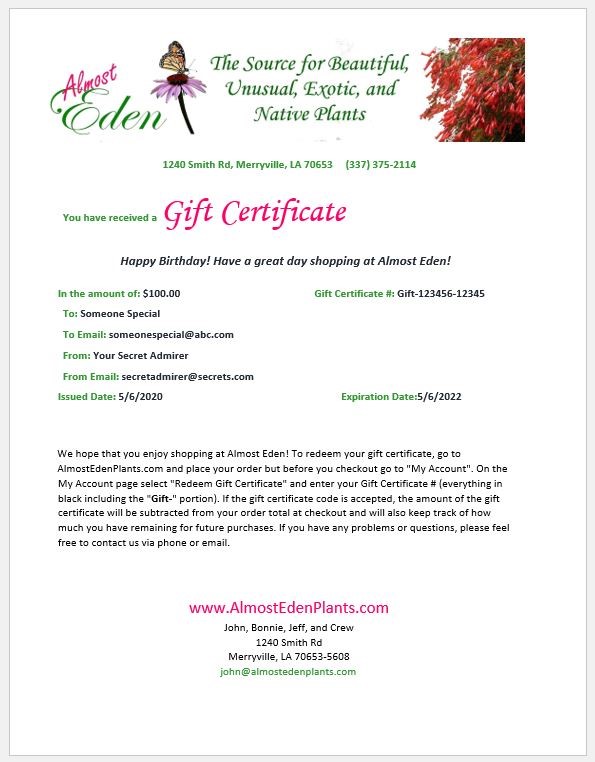
I received an Almost Eden Gift Certificate, how can I redeem it?
Select what plants that you would like to order and put them in your cart as you would normally.
Your order amount and gift certificate amounts do not have to match. If the total order amount is more than your gift certificate, you can pay the remaining balance at checkout like normal using PayPal or a credit or debit card. If the order amount is less than your gift certificate, the system will automatically deduct the order amount from that gift certificate and you will have a balance that you can apply to your next order.
Near the bottom of the page where you enter your billing and shipping addresses but above the green "Continue" button, you will see a field to enter your gift certificate code into. Enter the code exactly like it is on your gift certificate. It should look something like "Gift-111111-123456". Enter everything, including the word "Gift" and the dash after it or you will likely get an error.
If you have any problems using your Almost Eden gift certificate at checkout. Please denote that in the comments of your order including your gift certificate's code and we will work with you to get it all straight. Be sure to go ahead and complete the order but on the payment page select the "Phone Order" option.
Double Opt-In and Opt-Out Email Policy for Almost Eden's Newsletters
Unless you are signed up to receive Almost Eden's periodic newsletter, 4-6 per year typically, or are currently in contact with us via email or phone, you will only hear from us at your request for information or in the event that we need to contact you concerning your order.
You can subscribe to our newsletter at anytime at: https://forms.aweber.com/form/18/328234518.htm
We use a double opt-in system through AWeber.com for our email marketing for additional security and to help eliminate SPAM. You can learn more about how they secure your information at their website at: https://www.aweber.com/privacy.htm. The double opt-in system means that someone must enter their name and email in our online form. Then they will be sent a confirmation email with a link that they must click in order for the registration to be completed. You can unsubscribe at anytime from our newsletter by clicking the blue "Unsubscribe" link at the bottom of the newsletter. Please feel free to contact us if you have any issues, concerns, or questions.


